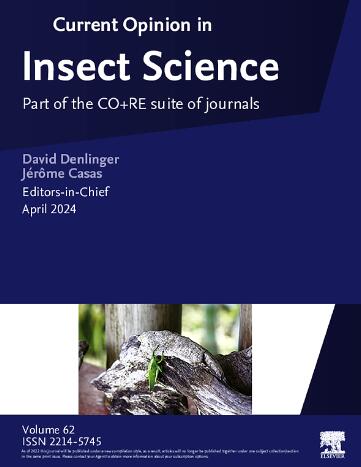Neuroanatomy of blood-feeding arthropods
IF 4.8
1区 农林科学
Q1 BIOLOGY
引用次数: 0
Abstract
Hematophagy has evolved independently numerous times across a variety of arthropods. Many of these blood-sucking animals, like kissing bugs or mosquitoes, transmit infectious diseases, resulting in numerous studies describing their sensory systems or ecology. Other species, like bed bugs or head lice, are not considered life-threatening but still elicit concern as a hygiene problem worldwide. Revealing the anatomy of the nervous systems in these arthropods expands our understanding of how they process environmental stimuli and locate hosts. Neural structures and the neuromodulators they express may be putative targets for vector control. In this review, we identify the known neuroanatomy of hematophagous arthropods, focusing on bed bugs, kissing bugs, lice, mosquitoes and other flies, and, finally, ticks. We also describe knowledge gaps and suggest areas of future study.
血食性节肢动物的神经解剖学。
在各种节肢动物中,噬血行为已经独立进化了无数次。许多这些吸血动物,如接吻虫或蚊子,传播传染病,导致许多研究描述了它们的感觉系统或生态。其他物种,如臭虫或头虱,不被认为是危及生命的,但仍作为卫生问题引起了全世界的关注。揭示这些节肢动物神经系统的解剖结构扩展了我们对它们如何处理环境刺激和定位宿主的理解。神经结构及其表达的神经调节剂可能是病媒控制的假定目标。在这篇综述中,我们鉴定了已知的食血节肢动物的神经解剖学,重点是臭虫、吻虫、虱子、蚊子和其他苍蝇,最后是蜱虫。我们还描述了知识差距,并提出了未来研究的领域。
本文章由计算机程序翻译,如有差异,请以英文原文为准。
求助全文
约1分钟内获得全文
求助全文
来源期刊

Current opinion in insect science
BIOLOGYECOLOGYENTOMOLOGY-ECOLOGY
CiteScore
10.40
自引率
1.90%
发文量
113
期刊介绍:
Current Opinion in Insect Science is a new systematic review journal that aims to provide specialists with a unique and educational platform to keep up–to–date with the expanding volume of information published in the field of Insect Science. As this is such a broad discipline, we have determined themed sections each of which is reviewed once a year.
The following 11 areas are covered by Current Opinion in Insect Science.
-Ecology
-Insect genomics
-Global Change Biology
-Molecular Physiology (Including Immunity)
-Pests and Resistance
-Parasites, Parasitoids and Biological Control
-Behavioural Ecology
-Development and Regulation
-Social Insects
-Neuroscience
-Vectors and Medical and Veterinary Entomology
There is also a section that changes every year to reflect hot topics in the field.
Section Editors, who are major authorities in their area, are appointed by the Editors of the journal. They divide their section into a number of topics, ensuring that the field is comprehensively covered and that all issues of current importance are emphasized. Section Editors commission articles from leading scientists on each topic that they have selected and the commissioned authors write short review articles in which they present recent developments in their subject, emphasizing the aspects that, in their opinion, are most important. In addition, they provide short annotations to the papers that they consider to be most interesting from all those published in their topic over the previous year.
 求助内容:
求助内容: 应助结果提醒方式:
应助结果提醒方式:


